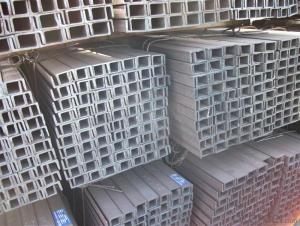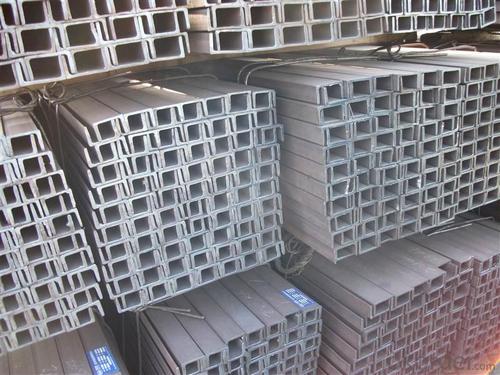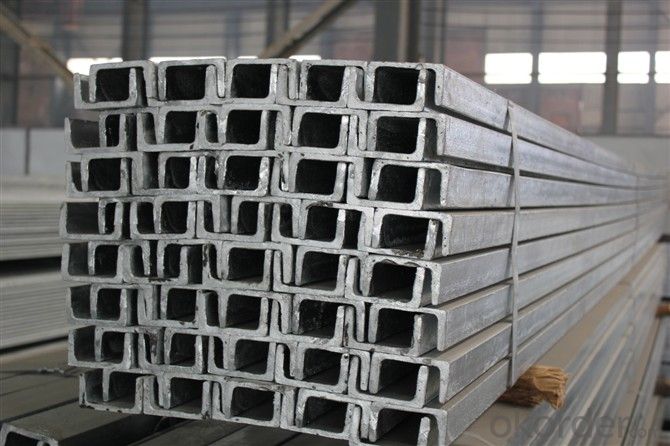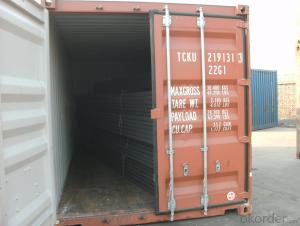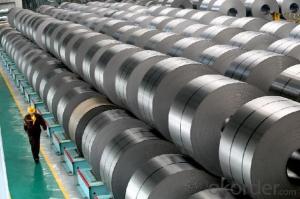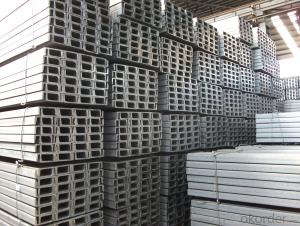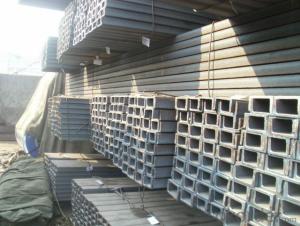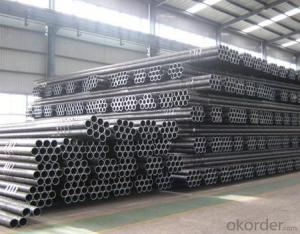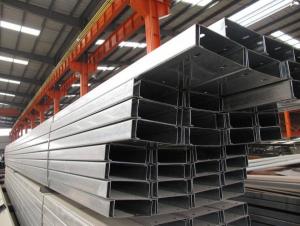Hot Rolled Steel channel U-Channel Channel steel for sale Made In China
- Loading Port:
- Tianjin
- Payment Terms:
- TT or LC
- Min Order Qty:
- 50 m.t.
- Supply Capability:
- 10000 m.t./month
OKorder Service Pledge
OKorder Financial Service
You Might Also Like
Product Description:
OKorder is offering Hot Rolled Steel channel U-Channel Channel steel for sale Made In China at great prices with worldwide shipping. Our supplier is a world-class manufacturer of steel, with our products utilized the world over. OKorder annually supplies products to European, North American and Asian markets. We provide quotations within 24 hours of receiving an inquiry and guarantee competitive prices.
Product Applications:
Hot Rolled Steel channel U-Channel Channel steel for sale Made In China are ideal for structural applications and are widely used in the construction of buildings and bridges, and the manufacturing, petrochemical, and transportation industries.
Product Advantages:
OKorder's Hot Rolled Steel channel U-Channel Channel steel for sale Made In China are durable, strong, and resist corrosion.
Main Product Features:
· Premium quality
· Prompt delivery & seaworthy packing (30 days after receiving deposit)
· Corrosion resistance
· Can be recycled and reused
· Mill test certification
· Professional Service
· Competitive pricing
Product Specifications:
Standard | GB/JIS |
Material Grade | Q235,SS400 |
Technique: | Hot Rolled |
Sizes as per chinese standard: | 50*37*4.5mm - 300*89*11.5mm |
Sizes as per japanese standard: | 50*25*3mm – 200*80*7.5mm |
Length: | 6meter, 9meter, 12meter |
Packaging & Delivery of Hot Rolled Steel U-Channel
1. Packing: it is nude packed in bundles by steel wire rod
2. Bundle weight: not more than 3.5MT for bulk vessel; less than 3 MT for container load
3. Marks:
Color marking: There will be color marking on both end of the bundle for the cargo delivered by bulk vessel. That makes it easily to disting Applications of MS Channel:
The MS Channel can be applied to construction of warehouses, workshops, sport stadiums and car parks etc.The hot rolled channel steel belongs to carbon structural steel which is applied to in the field of construction and machinery.In details, the hot rolled channel steel is usually used for arch-itechtural structure, and they could be welded in order to support or hang a vari-ety of facilities. They are also usually used in combination with I beam. Generally,the hot rolled channel steel we supply must possess perfect welding property, riveting property and mechanical property and so on.
Package & Delivery of MS Channel:
1.The hot rolled channel steel will be packed in bundle with steel wire at each end of every bundle and color marking in order to help the customer to recognize his goods more easily at sight.
2. And the hot rolled channel steel could be loaded into 20ft or 40ft container, or by bulk cargo.If the weight of each bundle reaches more than 3.5 mt, the loading by break bulk cargo should be choosed.When the weight of each bundle reaches less than 3mt, the loading by container should be choosed.
3.As for the transportaion from mill to loading port, the truck will be usually used. And the maximum quantity for each truck is 40mt.
4.All in all, we could do in accordance with customer's request
FAQ:
Q1: Why buy Materials & Equipment from OKorder.com?
A1: All products offered byOKorder.com are carefully selected from China's most reliable manufacturing enterprises. Through its ISO certifications, OKorder.com adheres to the highest standards and a commitment to supply chain safety and customer satisfaction.
Q2: How do we guarantee the quality of our products?
A2: We have established an advanced quality management system which conducts strict quality tests at every step, from raw materials to the final product. At the same time, we provide extensive follow-up service assurances as required.
Q3: How soon can we receive the product after purchase?
A3: Within three days of placing an order, we will begin production. The specific shipping date is dependent upon international and government factors, but is typically 7 to 10 workdays.
Q4: What makes stainless steel stainless?
A4: Stainless steel must contain at least 10.5 % chromium. It is this element that reacts with the oxygen in the air to form a complex chrome-oxide surface layer that is invisible but strong enough to prevent further oxygen from "staining" (rusting) the surface. Higher levels of chromium and the addition of other alloying elements such as nickel and molybdenum enhance this surface layer and improve the corrosion resistance of the stainless material.
Q5: Can stainless steel rust?
A5: Stainless does not "rust" as you think of regular steel rusting with a red oxide on the surface that flakes off. If you see red rust it is probably due to some iron particles that have contaminated the surface of the stainless steel and it is these iron particles that are rusting. Look at the source of the rusting and see if you can remove it from the surface.
Images:
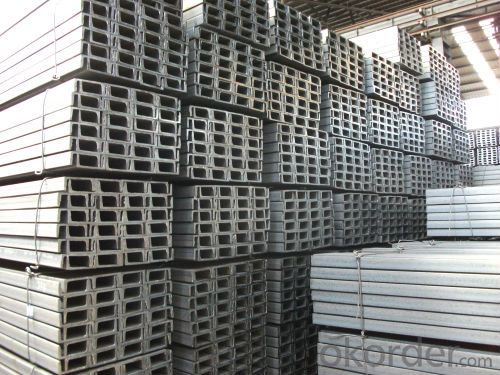


- Q: What are the applications of steel channels?
- Steel channels have a wide range of uses in different industries and sectors. In the construction industry, they are commonly employed as structural components in building frames, bridges, and other infrastructure projects. Steel channels offer strength, stability, and load-bearing capacity, making them suitable for supporting heavy loads and enduring environmental factors like wind, earthquakes, and extreme temperature changes. Besides construction, the manufacturing industry also extensively utilizes steel channels. They are often incorporated into the production of machinery, equipment, and vehicles. Steel channels can be employed as support structures in manufacturing plants and in the fabrication of frames, conveyors, and racks. Their high strength-to-weight ratio makes them ideal for such applications. In the renewable energy sector, steel channels play a crucial role, particularly in the construction of solar panel mounting systems and wind turbine towers. Thanks to their durability and resistance to corrosion, steel channels provide a dependable and sturdy framework for these renewable energy installations. Furthermore, the automotive industry frequently employs steel channels. They are used in the chassis and body frames of automobiles to ensure structural integrity and enhance safety. The strength and rigidity of steel channels make them vital components for maintaining vehicle stability and performance. Additionally, steel channels are utilized in the manufacturing of storage systems like shelving, racking, and warehouse systems. They provide a robust framework for organizing and storing products in various commercial and industrial settings. Overall, the applications of steel channels are vast and diverse, spanning from construction and manufacturing to renewable energy and automotive industries. Their strength, durability, and versatility make them indispensable components in numerous sectors, contributing to the development of robust and reliable structures and equipment.
- Q: Can steel channels be used in shipbuilding?
- Indeed, shipbuilding incorporates the utilization of steel channels. Due to their robustness, longevity, and adaptability, steel channels are widely employed in ship construction. These channels serve as a reliable source of structural support and find application in various tasks such as framing, stiffening, and reinforcing different sections of the ship's hull and superstructure. Specifically designed to endure the adverse conditions encountered at sea, including wave impact, corrosion, and extreme temperatures, steel channels prove their resilience. Additionally, their weldability facilitates efficient assembly and repair procedures. In summary, steel channels constitute a vital element in shipbuilding, playing a critical role in upholding the vessel's strength and integrity.
- Q: What is the elastic modulus of steel?
- When the material is in the elastic deformation stage, its stress and strain should be changed into a positive proportion (that is to say, according to Hooke's law), and the coefficient of proportionality is called the elastic modulus. The elastic modulus of the unit is dyne per square centimeter. "Modulus of elasticity" is a physical quantity describing the elasticity of matter. It is a general term. It can be expressed as "Young's modulus", "bulk modulus" and so on.When it is difficult to cause confusion, the modulus of elasticity of a general metallic material refers to Young's modulus, i.e., positive modulus of elasticity.Unit: E (elastic modulus) MPa (MPa)
- Q: Can steel channels be used in the construction of mezzanine floors?
- Mezzanine floors, which are commonly utilized in industrial and commercial settings to expand available space, can indeed incorporate steel channels. Renowned for their durability and strength, steel channels are frequently employed in construction projects. Within mezzanine floor construction, steel channels serve as beams or joists, offering essential structural support. Their ability to endure substantial loads ensures a dependable and secure platform for various applications, including storage, offices, and additional workspace. Moreover, steel channels can be tailored to meet specific design and structural prerequisites, rendering them an adaptable option for mezzanine floor construction.
- Q: Can steel channels be used for raised flooring systems?
- Indeed, raised flooring systems can utilize steel channels. The strength and durability inherent in steel channels render them a highly favorable option for bolstering raised floors. These channels may be arranged in a grid-like fashion, furnishing a sturdy foundation for the raised floor panels. Furthermore, steel channels readily bear heavy burdens, rendering them apt for spaces characterized by extensive foot traffic or equipment setups. Additionally, their resistance to corrosion ensures a prolonged lifespan for raised flooring systems.
- Q: How do steel channels contribute to sustainable design in buildings?
- Steel channels play a crucial role in promoting sustainable design in buildings due to their numerous advantages in terms of durability, recyclability, and energy efficiency. Firstly, steel channels are known for their exceptional durability, which contributes to the longevity of buildings. Unlike other materials, steel channels have a high resistance to corrosion, weathering, and pests. This durability reduces the need for frequent maintenance and replacement, leading to a decrease in the overall environmental impact of the building. Secondly, steel channels are highly recyclable. At the end of a building's life cycle, steel channels can be easily dismantled and recycled, ensuring that they do not end up in landfills. This recycling process requires significantly less energy compared to the production of new steel, resulting in reduced carbon emissions and conservation of natural resources. Furthermore, steel channels enable energy-efficient designs in buildings. Due to their high strength-to-weight ratio, steel channels allow for the construction of lighter structures, reducing the amount of material required. This, in turn, leads to a decrease in energy consumption during construction and transportation. Additionally, steel channels can be easily integrated with insulation systems, improving the building's thermal performance and reducing the need for excessive heating or cooling. Moreover, steel channels can be prefabricated off-site, minimizing construction waste and improving productivity through precise manufacturing. This process reduces the environmental impact of construction activities, such as noise, dust, and energy consumption. Lastly, steel channels provide design flexibility, allowing architects and engineers to create innovative and sustainable structures. Their versatile nature allows for the implementation of various design techniques, such as modular construction and adaptive reuse. These strategies contribute to sustainable development by optimizing space, reducing material waste, and promoting resource efficiency. In conclusion, steel channels are an essential component of sustainable design in buildings. Their durability, recyclability, energy efficiency, and design flexibility contribute to the reduction of environmental impact, conservation of resources, and promotion of sustainable practices in the construction industry.
- Q: What should I do with a screw or nut or bolt on the ramp?
- The bolt or nut on the inclined plane is easy to cause notch sensitivity, and the test type is wedge load.1. inclined planes on the upper and the inclined angles such as the angle of the gasket, so that the installation surface level.2. design changes into planes.3. on the slant drilling, reaming hole for the bolt head or nut. The hole bottom surface is a plane.
- Q: How do steel channels contribute to energy efficiency?
- Steel channels contribute to energy efficiency by providing a strong and durable framework for buildings, allowing for better insulation and reduced energy wastage. They also facilitate the installation of energy-efficient systems, such as HVAC and electrical systems, which further enhance energy efficiency.
- Q: Can steel channels be used for creating curved or angled sections?
- Yes, steel channels can be used for creating curved or angled sections. They can be bent or cut to the desired shape, allowing for flexibility in design and construction.
- Q: 10kV and below the distribution cabinet in the room, the basic channel should be higher than the indoor ground level? Which specification is clearly defined?
- The distribution cabinet is used in occasions where the load is more dispersed and the circuit is less. The motor control center is used in the situation where the load is concentrated and the circuit is more. They distribute the power of a circuit to the nearest load. This class of equipment provides protection, monitoring and control of loads.
Send your message to us
Hot Rolled Steel channel U-Channel Channel steel for sale Made In China
- Loading Port:
- Tianjin
- Payment Terms:
- TT or LC
- Min Order Qty:
- 50 m.t.
- Supply Capability:
- 10000 m.t./month
OKorder Service Pledge
OKorder Financial Service
Similar products
Hot products
Hot Searches
Related keywords
